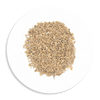
Valerian Root

Valerian Root
FAQs
Why does Valerian root smell so strong?
Valerian root has a famously pungent aroma, often compared to old cheese or dirty socks. This is due to the presence of isovaleric acid and other volatile compounds that become more pronounced as the root dries. While cats love the smell, it is an acquired taste for humans!
What does Valerian root tea taste like?
The taste is much milder than the smell suggests. It has a distinctive earthy, musky, and slightly bitter flavour. Because of its strong character, it is almost always blended with other herbs like chamomile, peppermint, or lemon balm to create a more balanced and palatable tea.
What is the best way to prepare cut Valerian root?
The ideal method for a tough root like Valerian is a decoction. This involves adding the root to cold water in a saucepan, bringing it to a boil, and then gently simmering for 10-15 minutes to fully extract its properties. A simple steep in a cup is not as effective.
What is Valerian root traditionally used for?
Valerian has been used for over 2,000 years, dating back to ancient Greece and Rome. It is one of the most well-known traditional Western herbs for promoting relaxation and calming the nerves, and is a very common ingredient in 'sleep' or 'night-time' tea blends.
When is the best time to drink Valerian tea?
Due to its traditional association with relaxation and sleep, Valerian tea is best consumed in the evening, about 30-60 minutes before you plan to go to bed, as part of a calming wind-down ritual.
Are there any safety precautions for Valerian root?
Yes. Valerian should not be used during pregnancy or breastfeeding. It may cause drowsiness, so avoid driving or operating heavy machinery after consumption. It's essential to consult a healthcare professional before use if you are taking any medications, especially sedatives.





